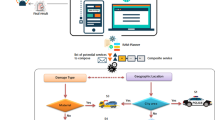Abstract
Web services composition techniques are gaining momentum as the opportunity to establish reusable and versatile inter-operability applications. Many researchers propose their composition approach based on planning techniques. We propose our context aware planning method which comprises global planning and local optimization based on context information. The major technical contributions of this paper are: (1) We propose an ontology-based framework for the context-aware composition of Web services. Context model, which are structured based on OWL-S, captures the Service-related, Environment-related, and User-related context and can be used in an unambiguous, machine interpretable form. (2) We propose context-aware plan architecture and thus is more scalability and flexibility for the planning process, and thereby improving the efficiency and precision. (3) We propose a hybrid approach to build a plan corresponding to a context-aware service composition, based on global planning and local optimization, considering both the usability and adoption. We test our approach on a simple, yet realistic example, and the preliminary results demonstrate that our implementation provides a practical solution.
Similar content being viewed by others
References
Alonso G, Casati F, Kuno H and Machiraju V (2003). In: Web Services. Springer, Heidelberg
Sheth A and Miller J (2003). Web services: technical evolution yet practical revolution. IEEE Intell syst 18(1): 78–80
McIlraith S, Son T and Zeng H (2001). Semantic web services. IEEE Intell Syst 16(2): 46–53
Sirin E, Parsia B (2004) Planning for semantic web services. In: In semantic web services workshop at 3rd international semantic web conference
Liang-Zhao Z, Benatallah B, Ngu AH, Dumas M, Kalagnanam J and Chang H (2003). Qos-aware middleware for web services composition. IEEE Trans Softw Eng 30(5): 311–327
Dey AK, Abowd GD, Salber D (2001) A conceptual framework and a toolkit for supporting the rapid prototype of context-aware applications. Human-Comput Interact J, Special Issue on Context-Aware Computing 16(1)
Baader F, Calvanese D, McGuinness D, Nardi D, Patel-Schneider PF In: The description logic handbook: theory, implementation, and applications. Cambridge University Press, London (2003)
Harel D and Naamad A (1996). The statemate semantics of statecharts. ACM Trans Softw Eng Methodol 5(4): 293–333
Maamar Z, Mostefaoui SK and Yahyaoui H (2005). Toward an agent-based and context-oriented approach for web services composition. IEEE Trans Knowl Data Eng 17(5): 686–697
Nau DS, Au TC, Ilghami O, Kuter U, Murdock W, Wu D and Yaman F (2003). Shop2: an htn planning system. J Artif Intell Res 20(4): 379–404
McIlraith S, Son T and Zeng H (2001). Semantic web services. IEEE Intell Syst 16(2): 46–53
McIlraith S, Son T (2002) Adapting golog for composition of semantic web services. In: Proceedings of the 8th international conference on principles of knowledge representation and reasoning (KR 2002), pp 482–493
Wu D, Sirin B, Hendler E (2003) Automating daml-s web services composition using shop2. In: Proceedings of the 2nd International Semantic Web Conference, pp 195–210
Pistore M, Barbon F, Bertoli P, Shaparan D, Traverso P (2004) Planning and monitoring web service composition. In: Proceedings of the 14th international conference on automated planning and scheduling, pp 247–252
Pashtan A (2005). Ontology of mobile user context. In: (eds) In: Mobile web services, pp. Combridge unversity press, London
Loke SW (2004) Logic programming for context-aware pervasive computing: Languages support, characterizing situations, and integration with the web. Web Intell, pp 44–50
Zhu Y (2003) A survey on grid scheduling systems. Computer Science Department of Hong Kong University of Science and Technology Technical report
Nahrstedt K, Xu D, Wichadakul D and Li B (2001). Qos-aware middleware for ubiquitous and heterogeneous environments. IEEE Commun Mag 39(11): 2–10
Baader F, Lutz C, Milicic M, Sattler U, Wolter F (2005) A description logic based approach to reasoning about web services. In: Proceedings of the WWW 2005 workshop on web service semantics (WSS2005), Chiba City
Baader F, Milicic M, Lutz C, Sattler U, Wolter F (2005) Integrating description logics and action formalisms for reasoning about web services. LTCS-Report LTCS-05-02, Chair for Automata Theory, Institute for Theoretical Computer Science, Dresden University of Technology, Germany. See http://lat.inf.tu-dresden.de/research/reports.html
Buhler P and Vidal JM (2003). Semantic web services as agent behaviors. In: Burg, B (eds) Agentcities: challenges in open agent environments., pp 25–31. Springer, Heidelberg
Mokhtar SB, Georgantas N, Issarny V (2005) Ad hoc composition of user tasks in pervasive computing environments. In: Proceedings of the 4th workshop on software composition. (2005 LNCS3628)
Maamar Z, Alkhatib G, Mostefaoui SK (2004) Context-based personalization of web services composition and provisioning. In: Proceedings of the 30th EUROMICRO Conference
Vukovic M, Robinson P (2004) Adaptive, planning based, web service composition for context awareness. Adv Pervasive Comput, pp 247–252
Lin F, Qiu L, Huang H, Yu Q, Shi Z (2006) Description logic based composition of web services. In: Proceedings of the 9th Pacific Rim International Workshop on Multi-Agents, PRIMA, pp 199–210
Qiu L, Shi Z, Lin F (2006) Context optimization of ai planning for services composition. In: IEEE International Conference on e-Business Engineering, pp 610–617
Author information
Authors and Affiliations
Corresponding author
Additional information
This research was partially supported by the National Science Foundation of China (No.90604017), the national 973 Project of China (No.2003CB317004) and the Nature Science Foundation of Beijing (No.4052025).
Rights and permissions
About this article
Cite this article
Qiu, L., Chang, L., Lin, F. et al. Context optimization of AI planning for semantic Web services composition. SOCA 1, 117–128 (2007). https://doi.org/10.1007/s11761-007-0010-3
Received:
Revised:
Accepted:
Published:
Issue Date:
DOI: https://doi.org/10.1007/s11761-007-0010-3




